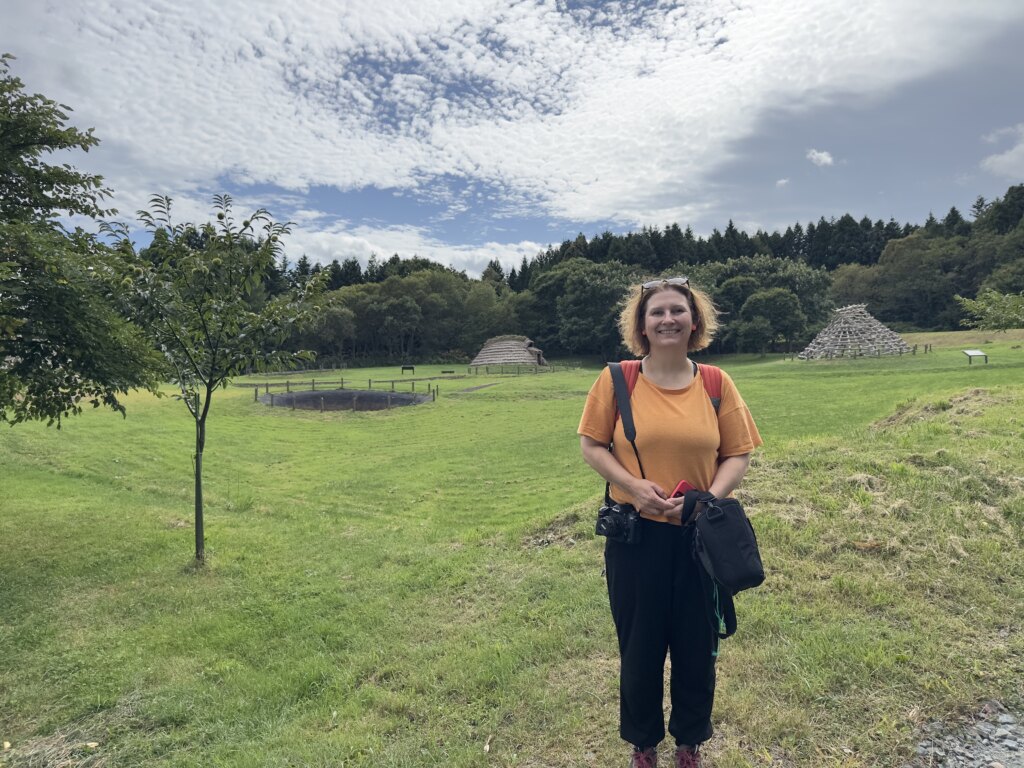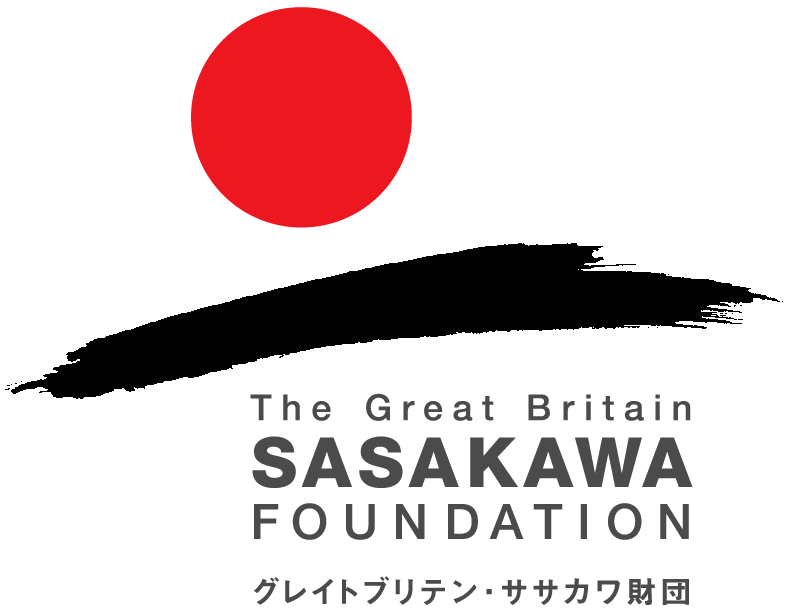Antonia Thomas
Programme Leader MA Contemporary Art and Archaeology
UHI Orkney (Scotland, UK)

Introduction
In September 2024 I was invited to take part in Cross Section: Art and Archaeology, a research residency in Hokkaido, as a guest of S-AIR. I currently lead an MA course in Contemporary Art and Archaeology at the University of the Highlands and Islands in Orkney, and my research has two main strands: Neolithic art and architecture, and the relationship between contemporary art and archaeology. I have wanted to visit Japan for as long as I can remember, and I jumped at the chance to learn more about art and archaeology in Hokkaido.
Art and Archaeology in Orkney
Orkney is an archipelago of around 70 islands, of which 13 are inhabited. The islands are located off the north coast of mainland Scotland, and so I instantly felt a connection with Hokkaido! Orkney is world-famous for its prehistoric archaeology and also has a lively contemporary art scene. There is even an active Orkney-Japan Association, which organises events and cultural activities. Although Orkney’s population is only about 22,000, we have around 500,000 tourists visit the islands each year, many of whom come to visit The Heart of Neolithic Orkney World Heritage Site. This comprises four main sites, all dating to around 5,000 years old; the two stone circles of the Ring of Brodgar and the Stones of Stenness, the passage grave of Maeshowe, and the stone houses of Skara Brae.
There is currently no evidence for direct contact between Japan, and Scotland, in the Neolithic or Jōmon periods. But there are many striking parallels between the prehistoric archaeological monuments, and artefacts, found in both places. Like the stone circles in Japan, the Ring of Brodgar and the Stones of Stenness were also built over many generations. and were connected to the passing of the seasons. Many of the sites in Orkney were also oriented on astronomical alignments and prominent features in the landscape.
World Heritage Archaeology
During my research trip, I was able to visit some of the 17 archaeological sites which make up the “Jōmon Prehistoric Sites in Northern Japan”, which were collectively inscribed on the UNESCO World Heritage Site list in 2021. These bear a unique testimony to the development of the pre-agricultural but sedentary Jōmon culture and its complex spiritual belief system over some 10,000 years – an incredible length of time. The first time I had heard about Jōmon period stone circles was a couple of years ago, when I saw the publicity around the Circles of Stone: Stonehenge and Prehistoric Japan exhibition at the Stonehenge visitor centre. Stonehenge, along with Avebury and associated sites was inscribed on the UNESCO World Heritage Site list in 1986 and was amongst the first seven sites given this designation in the UK. Orkney had to wait until 1999 to get World Heritage recognition for its Neolithic archaeology.
During my visit, I went to Ofune, with its burial pits and pit dwellings, and also Kakinoshima. I was so impressed by the quality of the museum displays everywhere I went, and I have now become obsessed with dogu! Seeing the chuku-dogu, the first artefact from Hokkaido to be designated a national treasure in 2007, was a real highlight. I also found the clay tablets, with the imprint of dead children’s feet pressed into them, really powerful and moving. Some artefact types, such as the polished stone axes, and coarse grinding stones and querns, were strikingly similar to those found in Orkney, but others – the dogu, the lacquerware, jade beads – couldn’t have been more different. I also found the Fugappe rock carvings intriguing; so different from the sort of rock art I am used to studying, which is generally linear and abstract.
World Class Art
It was wonderful to see the rich array of different materials and artefacts in the museum displays, but what made my trip to Hokkaido really special was being able to meet so many amazing contemporary artists. One of the highlights for me was meeting Rie Kawakama and seeing her studio and then seeing an exhibition of her sculptures a few days later. In Shiraoi, I was also fortunate to meet Kineta Kunimatsu in his studio and see his amazing wooden sculptures. All the contemporary art that I saw seemed to be connected through a deep understanding of landscape and materials – whether wood, steel, ceramics, or stone – and how people are connected to the natural environment. This interaction with, and appreciation of, the natural world was also evident in the Ainu sites that we visited, and I enjoyed learning about the rich indigenous cultural traditions of Hokkaido – I hope to do further research on Ainu art and culture.
Aomori
Nearly all of my two-week stay in Japan was spent in Hokkaido, but we did head south for two nights to Aomori Prefecture, so I could visit one of the most important Jōmon sites in Japan: Sannai-Manuyama. It was exciting to get the world-famous shinkansen through the Seikan Tunnel, which I learnt is the world’s longest undersea tunnel by overall length (apparently the Channel tunnel between England and France has a longer undersea segment but is shorter overall). I was overwhelmed by the vastness of the Aomori Museum of Art, which opened in 2006, and the quantity of artwork on show. I particularly enjoyed the exhibition of Shikō Munakata’s woodcut prints, and the wider displays of crafts relating to the mingei movement, such as sashiko and boro, traditional Aomori crafts borne out of poverty and now globally fashionable.
Of all the archaeological sites I visited during my trip, Sannai-Maruyama is perhaps the most impressive and is the best known internationally. I have never seen anything quite like the reconstructed pillar supported building, and it raised many questions about the use of such a large, monumental structure. I was fascinated to discover that the Aomori Museum of Art had been deliberately built next to Sannai-Maruyama, to explicitly reference the archaeological site. I read that the museum’s architect, Aoki Jun, had even been inspired by the Early to Middle Jōmon Period site in designing the gallery, with the sunken aspects of some of the building intended to reflect the subterranean appearance of the excavation site. It was wonderful to see contemporary art reference prehistoric archaeology in this way, a juxtaposition that seems to suggest that both ancient and modern visual and material culture are all part of the same important expression of shared identity, and part of what makes us human.
Muroran
I visited Muroran twice during my trip. The first time was on the way back north from Aomori, where we were able to catch the last day of the exhibitions at Etomo School as part of the Muroran Art project (MAP). There were many enjoyable installations, but the highlight for me was the exhibition of black-and-white photographs of late 20th-century Muroran by Koji Sakai, whose evocative images really captured the essence of the industrial city. I also enjoyed the small museum at the school, which explained about the Jōmon shell mound and burials that had been found when it was built.
I returned to Muroran, and Etomo School, a few days later, to give a public presentation about prehistoric archaeology in Orkney, and to take part in Hisashi Shibata’s Stone Circle 2024 workshop and the construction of a stone circle in the school gymnasium. I contributed a small stone that I had brought with me from Orkney. It was a waterworn pebble of Devonian sandstone, a sedimentary rock that had been laid down as sediments in a lake basin around 400 million years ago. I like to think of this small pebble still in Hokkaido somewhere, a little piece of Orkney in Japan!
I really enjoyed visiting Muroran. As a town, it reminded me of the industrial part of northern England that I had grown up in, and Etomo School was one of the most interesting buildings I saw during my visit. I am a real fan of mid-century architecture, and I was fascinated to read about architect Kanao Sakamoto’s famous circular buildings, and how he was influenced by the ideas of Buckminister Fuller. Taking part in the stone circle workshop, in that wonderful circular building made me think about the enduring power of the circular archetype, from prehistoric stone circles (in Japan and in Britain), to the modern day and 20th-century architecture.
Contemporary Archaeology?
One aspect of Japanese archaeology that really stood out to me was that for most Japanese archaeologists, and others, archaeology is always concerned with the ancient past, and usually with excavation. In the UK (and some other western countries), the past two decades have seen the definition of archaeology widened to also include more recent sites, artefacts, and remains. Often termed ‘contemporary archaeology’, this might seem like an oxymoron to many people! But archaeological methods and theories can be a powerful way of investigating our recent past, bridging the gap between memories and records, and allowing for the recording of often very personal events and what anthropologist James Deetz called ‘the small things forgotten’. Nor does archaeology have to concern itself with excavation; archaeological approaches to standing buildings can highlight the way that spaces were inhabited and used, linking material remains to living memories.
For example, recording Kanao Sakamoto’s circular buildings – before they all disappear – could be an important contemporary art-archaeology project, involving archaeologists and artists working together. Seeing the way that artists are documenting these more recent sites in Japan was really inspiring, and in many ways, this is a form of contemporary archaeology. If I manage to return to Japan, I hope to see more of these circular buildings before they all disappear.
There were so many highlights to my research visit, and I have only had space to mention a few of them here, but I hope to return in the future and learn more about the incredible art and archaeology of northern Japan.
Acknowledgements
I am extremely grateful for being given the opportunity to take part in this residency and visit Hokkaido. I was able to see some of the most impressive collections of archaeological artefacts I have ever seen anywhere, in world class museums, and meet some truly inspiring artists. I was honoured to speak at Naebono Studio for the Cross Section: Art and Archaeology seminar, alongside artist/researcher Sahoko Aki, and Yasuyuki Yoshida, and to hear more about art and archaeology collaborations and practice in Japan. It was also wonderful to see Ryusuke Ito again, having met in Orkney previously.
I hope to be able to return at some point in the next few years to see the rest of the archaeological sites which make up the “Jōmon Prehistoric Sites in Northern Japan”, and to learn more about the way in which these have influenced contemporary artists. I hope that this research trip will be the first of many as part of a long-standing collaborative relationship, so I can continue some of the conversations I had with all the wonderful people I met. Thank you to S-AIR, and the Great Britain Sasakawa Foundation for making it possible!
I was welcomed with such generosity and kindness during my visit, and particular thanks must go Kyoko Tachibana and Matt Webb for being such an excellent host and translator, Hisashi Shibata for hosting me, Fuyuka Shindo, Rie Kawakami and Maki Kurisu for being such wonderful guides, and everyone else that I met during my time in Japan. I really hope that I can meet everyone again, whether in Hokkaido, or Orkney!
Cross Section: Art and Archaeology
Organised by NPO S-AIR
Funded by Great Britain Sasakawa Foundation
WIth support from naebono art studio, Sapporo Tenjinyama Art Studio
